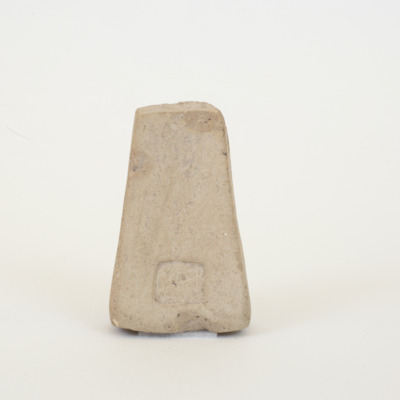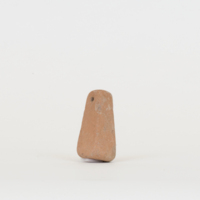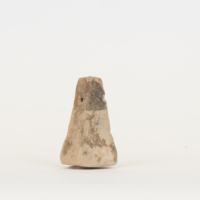Loom Weights in Burial Contexts
Peucetian Burials: Introduction
Settlement patterns in Peucetia reveal a model of urbanization, starting before the 6th century BCE, and culminating in the large fortified urban centres of the 4th century BCE. This development involved increased social stratification and the emergence of an elite class, whose prominence was evoked in death, in its burials. The burials also reveal the importance imputed to banqueting rituals, intended to commemorate shared roles in communities. Consequently excavated tomb groups provide an important source of evidence for the social and cultural organization of Peucetian societies.[1]
Loom weights similar to ours have been found in Peucetian tomb assemblages of roughly late 6th to 4th century date, when these burial patterns emerge. The loom weights are difficult to date precisely without a stratigraphic or other archaeological context, since like most utilitarian artefacts, regardless of the function or symbolic value they might have acquired, they did not evolve much stylistically over time. However, studies of loom weights found in dated contexts at other sites in southern Italy, including Apulia, demonstrate that the truncated pyramidal loom weight with one suspension hole, like those in our collection, was the most prevalent type from the 6th to 4th centuries BCE. This dating is consistent with the approximate date of the other material in the Donati collection-mostly ceramic, based on comparison to published tomb groups. It is also consistent with the period, during which the burials mark status, and more often, communal roles of the deceased.[2]
Interpreting the Burials
In order to contextualize the loom weights and other material in the Donati collection, it is necessary to consider recent studies of tomb material in Peucetian burials, which have raised questions about gender identity, social structure, and models of appropriation by indigenous communities, of Greek material culture. Traditionally archaeologists connect the presence of Greek objects in tombs to the process of acculturation through the imitation of typical status and gender signifiers used by the local Greek populations, namely Greek-type weapons, and drinking vessels used in the symposium, the drinking banquet restricted, in the Greek world, to Greek male citizens.[3] Following this premise the burials have been invoked as evidence of kinship-based, warrior aristocracies, in which a male warrior class was dominant, and by the 6th century BCE, using these objects as expressions of its prominence.[4] While this clearly is the case in some contexts, recent interpretations of the function and meaning of tomb material, which are not restricted to Hellenizing (and patriarchal) models, reveal that other criteria were involved in the selection tomb furniture, apparently with little or no regard for status, age or gender.[5] For example, several ceramic forms normally associated with women and matronly propriety in Greek contexts have been found in adult male tombs in Peucetia, suggesting that these artefacts were not necessarily gender markers imbued with the same meaning, but were repurposed to fit into banqueting, the most prevalent ritual performed at the burial.[6] In addition, it has been suggested that the presence of weapons in Peucetian burials of both men and women, rather than exclusively marking social and male gender status, may have been intended in some cases to evoke a more, universal idealized composite of shared behavior that was recognized and expected by the entire community.[7] However it is the funerary banquet that is the most prominent ritual attested by the burials, celebrated, it has been argued, to express community identities more frequently than individual elite status competition.[8] This pattern is demonstrated by the prodigious number of vessel types associated with (wine) drinking, feasting and food preparation in both male and female burials of all levels of social and wealth status, dating from the 6th to the middle of the 4th century BCE.[9] This pattern for example, is not typical of Messapian burials, where special drinking vessels appear to have been restricted to elite males in the community.[10] Peucetian burials show remarkably, that men, women and even small children were buried with large vessels for drinking and serving wine, and that the banquet was a universal funeral ritual, accessible to all members of the community, regardless of status or gender.[11] More broadly, the tomb assemblages are consistent with a typical model of “cross cultural consumption,” in which an object is taken from its original context and reinvested with new meaning to respond to a different socio-political value system, in this case the banquet as metaphor of one’s shared role in the community.[12]
Loom Weights in Burial Contexts
It is in this context of indigenous culture, if not consumption,[13] that our loom weights should be considered: the pattern of distribution of loom weights in Peucetian burials suggests that they do not appear to have been invested with the same meaning and role as at other sites in southern Italy and the Greek world. Traditionally, loom weights and spindle whorls are associated with female burials because of the well-established connection between women and weaving. The presence of loom weights in female burials is thus regarded as a gender marker and symbol of a woman’s role and status as a weaver.[14] However in the case of the Peucetian burials, analysis of the skeletal remains indicates that loom weights occur in male tombs at the same rate as in female tombs, and in both cases they are not common.[15]
In Peucetian burials, it has been proposed that the apparent absence of a gender distinction for loom-weights, and their relative scarcity in the material record may suggest that they symbolized the activity of textile production in the broadest sense, as markers of the economic activity associated with them. As a symbol of control over markets that potentially reached beyond the local community, a loom weight in a male burial might have been regarded as symbol of professional prestige; in a female burial a loom weight would have been a symbol of community status and achievement.[16] Finally, in some contexts, loom weights do not appear to have been endowed with any symbolic meaning at all, but were simply practical in function: for example in the case of a burial, where loom weights were used to prop up the head of the deceased, and a male burial, where they appear to have secured a covering to protect the grave.[17]
Notes
[1] De Juliis 2010, 157-9; Liseno 2010, 169-176; Peruzzi 2016, 13-16; Kelly 2014, 254-65; De Juliis 1988, 99; Herring et al 2000, 250-51; Lomas 2000, 82-85; Ciancio, et al 2009, 307-308.
[2] Herring 2000, 68-69; Riccardi 1989, 69-89; De Juliis 2010, 159. Limestone sarcophagi, cist burials made of small overlapping stone blocks and rock cut chamber or semicamera tombs) signify elite status, while the majority, simple fossa inhumations (trenches cut into the bedrock or soil), represent more modest burials, see Small 2014b; 23-27; Peruzzi 2016, 86-90, 105-107; at Gravina di Puglia, Taylor et all 1977, PBSR 45: 69-103.
[3] See Dietler 2010, 1-54, 64-65; 1997, 475-478, for a survey of the historiography of the Hellenization model, and a discussion of the influence of European colonialism, including “a cultivated appreciation for the classics,” (at 477) on earlier interpretations.
[4] De Juliis 2010, 160-1; Riccardi 2003, 89-96; Chieco Bianchi Martini 1964, 148-164;
[5] Kelly 2014, 254-265; and Peruzzi 2016, 51-63, 68-70; from an anthropological perspective, based on the recognition that universally, “cross cultural consumption” (Dietler1997, 475) can be shown to have involved a more nuanced borrowing of colonial (Greek) prototypes than has been assumed in western (Classical) scholarship; see Dietler 2010, 55-73; 1997, 475-476; 483-488; also Herring, Whitehouse and Wilkins 2000, 235-256.
[6] Peruzzi 2016, 247-251; for example, in Athens the kalathos, a basket imitated in clay, was a female vase, used to hold wool for spinning, and often found in sanctuaries dedicated to female deities; in Peucetin burials however, kalathoi are found in male burials, and appear to have been associated with food offerings, an important element of Peucetian banquet rituals; a clay model of a kalathos with fruit is documented in a male burial (Tomb 2 /1979 in Conversano; in addition, painted examples adorned the walls of male tombs at Rutigliano (85/1978); rich male graves in Ruvo, Timmari, Altamura, and Rutigliano also contained locally made loutrophoroi, an Athenian shape (ovoid-bodied with tall neck and two or three handles), associated with women in Greek contexts, because they were used bring water for the bride’s prenuptial bath; finally, in lekanides (small lidded bowls) appear in both male and female Peucetian burials, while in Greece they are associated exclusively with women, as containers of jewellery and toiletries.
[7] Peruzzi 2016,72;Kelly 2014, 260-262;the ambiguous meaning of the warrior ideal and weapons is borne out by six female burials at Rutigliano, which contained bronze military belts, spear heads, and in some cases bronze or iron strigils; see De Juliis 2007, (Tombs 15, 33, 54, 84, 85 and 87); the Peucetians also uniquely associate the strigil, a symbol of athletic skill in Greek contexts, with weapons to express this ideal, see Herring, Whitehouse and Wilkins 2000, 252-55; Small 2000, 221-34.
[8] Peruzzi 2016, 268-269.
[9] Peruzzi 2016, 76, 43-63, 76, 242-243, 264-274.
[10] Kelly 2014, 257; Giannotta 2014b, 205.
[11] Peruzzi 2016; 95-96, 122-126; 263-269; Kelly 2014, 256-260; Perruzzi (126, 172-73; 269-274) observes changes in the dynamics of feasting rituals, that emerge in the first half of the 4th century BCE; they indicate that feasting rituals were now accessible, and practiced by a larger segment of the population, while a separate, smaller elite group (in Ruvo) defined itself by acquiring larger, more expensive commissions with elaborate iconographies, carefully selected for grander burials; for the broader anthropological meaning and function of feasting rituals, see Dietler (2001 65-75), who argues that they served as symbolic markers of social status and political power, or as markers of non-competitive and shared relations within a group; on the prominence of feasting in Iron Age burials of western Mediterranean and Celtic populations, see Dietler 1995, 64-71;1997, 488-492.
[12] Dietler 1997, 475; Peruzzi 2016, 37, 56-60.
[13] Loom weights were utilitarian, and while they might have been acquired from local Greek artisans for use in textile production, unlike Greek ceramics they (obviously) would not have been acquired specifically for funerary ritual since the value of a loom weight lay in its personal use, as a momento.
[14] Gleba 2008, 173; Riccardi, 2003:102-103.
[15] Kelly 2014 262-263; only 26 tombs with secure contexts have been published that contain one or more loom weights, and only 6 have been positively typed by gender on the basis of analysis of the anthropological remains: Rutigliano tombs 2, 5 (Didonna) and 38; Bitonto tomb 1 (1982) and tomb 2 (1983) and Bigetti tomb 1 (1990); of these, three have been identified as female, while the other three are males; of the three in Rutigliano, both the (single) female burial and the (two) male burials contained loom weights.
[16] Kelly 2014, 262-264.
[17] Peruzzi 2016, 251, at Bitonto, tomb B 1/1982 (via Chinise); Riccardi 2003, fig. 84; Peruzzi 2016, 153, at Rutigliano, five loom weights in tomb Rut. 50/1978.




